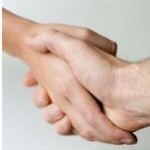I received a call from CBC radio last week asking me questions about Recession Etiquette. At first I was a bit surprised because I had never heard of Recession Etiquette. I couldn’t believe that there was a certain set of rules that we were supposed to follow while in a recession. It didn’t make sense to me at all.
But the more I listened to the person interviewing me, the more I realised that what she was really asking about was not a special kind of etiquette called recession etiquette. She wanted to know how we should treat people who are personally affected by the downturn in the economy. She also wanted to know if there were etiquette rules of behavior that people struggling financially should follow. Although I understood what information she wanted and I believe I answered her questions, I am still struggling with this term ‘Recession Etiquette’. I don’t know who coined the term Recession Etiquette, but I have to say that I disagree with the terminology.
Let’s face it, although many of us are affected by the global downturn there are not any special rules of behaviour that suddenly became important over the past year that were not important before. Almost everyone I know has gone through their own personal recession at one time or another. And this is an important issue no matter if there is a formal recession, or not.
If we think about the definition of etiquette compared to the definition of manners, Etiquette is the rules of conduct that we follow as a society. Manners are about being sensitive to others and making them feel comfortable. In other words, ‘the golden rule’;
In my opinion as an professional image/ etiquette consultant, if you are ever in a situation where you need to choose between following the rules of etiquette or using your manners by being sensitive to the needs of others, always choose manners first. Etiquette comes second.
Here is my take on some how to handle 4 situations that you might face during any recession.
If someone you know has lost their job; let them know that you heard they lost their job and let them know that you are there to help in any way you can. Be sensitive to whether they want to talk about it or not. And go with the flow without pushing the subject. According to western etiquette, money is considered a taboo topic. It is not appropriate to ask questions about someone’s finances. In this situation, some people will want to talk about what they are going through and others will not. Be open to listening and responding. However, if you get the feeling they don’t want to talk about it, be respectful and move onto a different topic.
Don’t assume that just because the person doesn’t have a job that they don’t want to socialize. Suggest free or inexpensive activities. Every community has them. During the day, go for a picnic rather than going to a restaurant. Go on a hike, play tennis or take the dogs for a long walk. In the evening get together at home: Play a game or watch a movie on TV.
Clients often ask me if it is alright to split the bill or ask for separate checks when dining out. Of course it is. Just make everyone knows this ahead of time. If you are on a budget, asking for separate checks is the best way to handle things if you concerned about the difference in what might be ordered.
When dining out, don’t forget to account for the tip in your dining budget. Remember, the service staff members generally receive a low salary and rely on their tips to get by. If the tip is a concern, suggest dining at a less expensive restaurant instead.
Since the recession is something that has affected most of us, one way or another, I would like to open up this topic and get your feedback, your etiquette questions and your comments. How has the recession impacted your social behaviour, reactions and responses? What do you think about the idea of recession etiquette?
Sign up for our blog on feedburner.

 If you would like to meet someone, when approaching that person:
If you would like to meet someone, when approaching that person:


